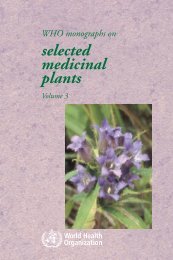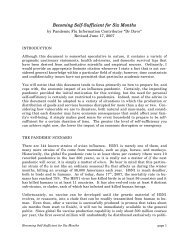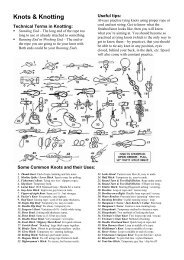Create successful ePaper yourself
Turn your PDF publications into a flip-book with our unique Google optimized e-Paper software.
COMMON EDIBLE MUSHROOMS<br />
raises the cap up into the air, the cap expanding as it is raised.<br />
Evidence that mushrooms have been formed below the surface<br />
of the ground can be seen in the pieces of dirt and debris that<br />
cling to the tops of freshly expanded specimens. These soft and<br />
delicate mushrooms can exert a surprising force when expanding<br />
in this way; they sometimes raise up rocks of several pounds'<br />
weight and have been known to force paving blocks up out of<br />
the street.<br />
Young mushrooms of some species are entirely enclosed in a<br />
protecting sheath of mycelium, which is broken as the mushroom<br />
expands. If this sheath remains as a cup-like structure around the<br />
base of the stem it is called a cup or volva. The patches or warts<br />
of mycelium scattered over the caps of some species of Amanita<br />
are the remains of this enclosing sheath. In many species a veil is<br />
formed by another sheath of mycelium extending from the edge<br />
of the cap to the stem, just beneath the gills. If this breaks at the<br />
margin of the cap when the cap expands, it may remain on the<br />
stem as a ring. If it breaks at the stem, remnants of it may hang<br />
from the margin of the cap for a short time, until they wither<br />
and disappear. Many species, however, lack cup or ring, or both.<br />
The spores of mushrooms and of the molds related to them are<br />
among the most persistent and numerous of our uninvited guests.<br />
Borne by the wind, they literally fill the air we breathe, fall unseen<br />
upon the food we eat, and even settle into our morning<br />
coffee as we drink it. Unnoticed and usually harmless, they are<br />
nevertheless omnipresent. When mushroom spores land in a favorable<br />
spot, they germinate, produce mycelium, and eventually<br />
give rise to another crop of mushrooms and spores. Since most<br />
mushrooms live on decaying vegetable matter they are likely to<br />
be abundant on various kinds of plant debris. Grassy places and<br />
forests are favorite environments. A few have very special tastes<br />
and grow only on the dung of certain kinds of animals, on specific<br />
kinds of trees, on the cones of certain evergreens, around<br />
the roots of certain grasses, on the caps of certain other mushrooms,<br />
and even on so unnourishing a thing as plaster!<br />
8
















